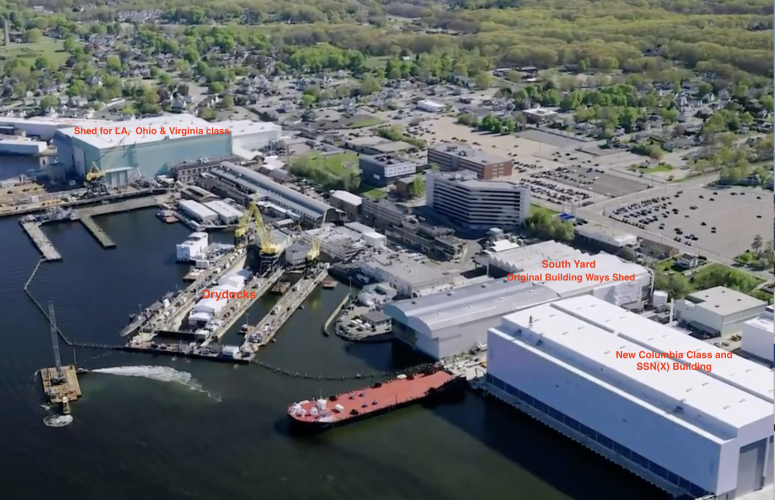- Joined
- 3 June 2011
- Messages
- 18,335
- Reaction score
- 12,232
And give them some real weapons.Arguably the USs greatest weapon system technological [still] advantage. I’d have SSNs & SSBNs/SSGNs rolling off the assembly line like sausage.
And give them some real weapons.Arguably the USs greatest weapon system technological [still] advantage. I’d have SSNs & SSBNs/SSGNs rolling off the assembly line like sausage.
Electric Boat has been expanding its facilities in both Groton, Connecticut and Quonset Point, Rhode Island. In Groton, a new land level facility for the Columbia class SSBNS was built next to the old South Yard sheds (which were originally open, inclined building ways. Many of the early nuclear submarines were built there (Nautilus, Seawolf, Skipjacks, Skates). These were covered over in the 1960's to shield form satellite reconnaissance and subsequently converted to storage sheds. The big green building was the land level facility for the Ohio SSBNs and now the Virginia class SSNs. Not visible are two sheds on the other side of the large green building were two smaller, covered sheds for the LA class SSNs. Those were not land level, but inclined ways. The subs were launched by sliding down the ways into the Thames River (I was there for the USS Hartford SSN "slide"). Land level facilities use mobile carts on rails to move the components during assembly, and then subsequently out to a floating deck that can submerge to place the submarine in the water. The rails can be seen in the Virginia class building photo.Arguably the USs greatest weapon system technological [still] advantage. I’d have SSNs & SSBNs/SSGNs rolling off the assembly line like sausage.

Yeah, I mentioned in another thread that good people are always going to be your real bottleneck:Electric Boat has been expanding its facilities in both Groton, Connecticut and Quonset Point, Rhode Island. In Groton, a new land level facility for the Columbia class SSBNS was built next to the old South Yard sheds (which were originally open, inclined building ways. Many of the early nuclear submarines were built there (Nautilus, Seawolf, Skipjacks, Skates). These were covered over in the 1960's to shield form satellite reconnaissance and subsequently converted to storage sheds. The big green building was the land level facility for the Ohio SSBNs and now the Virginia class SSNs. Not visible are two sheds on the other side of the large green building were two smaller, covered sheds for the LA class SSNs. Those were not land level, but inclined ways. The subs were launched by sliding down the ways into the Thames River (I was there for the USS Hartford SSN "slide"). Land level facilities use mobile carts on rails to move the components during assembly, and then subsequently out to a floating deck that can submerge to place the submarine in the water. The rails can be seen in the Virginia class building photo.
The Quonset Point facility has added two new buildings (shown in attached photos). These are used for hull section fabrication and partial outfitting of interior components. The hull sections are shipped by barge to the Electric Boat Groton site (or Newport News) for final integration and outfitting into the completed submarine.
I work in a technical capacity in defence, my wife works in financial services. We are both very good at what we do and recognised as such. My wife gets paid twice what I do, then gets bonuses that have never been less than 10% of my salary and have been more than my salary. She has also had share grants and share options.Yeah, I mentioned in another thread that good people are always going to be your real bottleneck:
We're making strides in getting talented young people into the industry--but time will tell if they're put in an environment where they can learn and thrive. I imagine the powers that be will devise a schedule that's far too aggressive and they'll end up behind the eight ball.
We'll see how it goes, though--these things are notoriously hard to predict.
They sorta are, but there's been some congestion in the upstream pipelines.Arguably the USs greatest weapon system technological [still] advantage. I’d have SSNs & SSBNs/SSGNs rolling off the assembly line like sausage.
They have one of the best torpedoes in the world, and what is probably the best subsonic cruise missile in the world available as weapons.And give them some real weapons.
